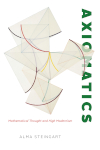- About MAA
- Membership
- MAA Publications
- Periodicals
- Blogs
- MAA Book Series
- MAA Press (an imprint of the AMS)
- MAA Notes
- MAA Reviews
- Mathematical Communication
- Information for Libraries
- Author Resources
- Advertise with MAA
- Meetings
- Competitions
- Programs
- Communities
- MAA Sections
- SIGMAA
- MAA Connect
- Students
- MAA Awards
- Awards Booklets
- Writing Awards
- Teaching Awards
- Service Awards
- Research Awards
- Lecture Awards
- Putnam Competition Individual and Team Winners
- D. E. Shaw Group AMC 8 Awards & Certificates
- Maryam Mirzakhani AMC 10 A Awards & Certificates
- Two Sigma AMC 10 B Awards & Certificates
- Jane Street AMC 12 A Awards & Certificates
- Akamai AMC 12 B Awards & Certificates
- High School Teachers
- News
You are here
Axiomatics: Mathematical Thought and High Modernism

Publisher:
University of Chicago Press
Publication Date:
2023
Number of Pages:
299
Format:
Paperback
Price:
35.00
ISBN:
978-0226824208
Category:
General
[Reviewed by , on ]
Daniel J. Curtin
02/29/2024
The author states, in the note to readers, “This book is a history of mathematical thought rather than of mathematics per se” and also “… I have tried to limit to a minimum the mathematical content in the book.” Both statements are true, yet still this book will be of great interest to many mathematicians. The author follows several important intellectual threads in mathematics from the end of the 19th century up to around 1980, including the conflict between pure and applied mathematics, and provides a deep attempt to explain the ideas that steered the direction mathematics took. A particularly interesting thread is the connection between the Modernist movement in art and the pull towards abstraction among professional mathematicians, even those doing “applied” work.
The following sketch is at best a cartoon, whereas the details are fleshed out in the book. Steingart tells interesting stories of mathematicians, historians, artists, setting the scene for many of the conflicts and disagreements that occurred, and also highlights the importance of mathematical approaches in a variety fields. Most importantly, Steingart’s presentation of the ideas that underlie the actual behavior of those in the arena is convincing.
As the title signals, axiomatics drives much of the early part of the story. David Hilbert published his famous full axiomatization of Euclidean geometry, Grundlagen der Geometrie in 1899. Against earlier views of axioms as self-evident truths, Hilbert believed that the truth of an axiom system came from its consistency, i.e., that no contradiction could be deduced from the axioms. Thus the notion of abstraction changed from an induction from nature or from examples to pure consideration of logical deductions.
American mathematicians in the early 20th century took to this approach, as a result which pure mathematics dominated right up to the Second World War. During that war, the technical needs of the US military lead to a rise in importance of applied mathematics, driving a split between applied and pure mathematicians.
After the war the split continued, magnified by the large influx of federal money to scientific research. Pure mathematicians managed to secure their grip on graduate studies, so pure mathematics dominated the universities well into the 1970s.
Starting before WWII, but accelerating therafter, many in the social sciences sought to mathematize their subject, favoring an axiomatic approach and only later statistical approaches. Axiomatics and abstraction entered new regions of the academy.
As Steingart documents, many pure mathematicians justified the highly abstract approach intellectually by explicitly tying it to the Modernist movement in the arts, which emphasized form, shape, and color rather than realistic representations, ultimately leading to abstract art She shows how mathematicians such as Paul Halmos cited art critics like Clement Greenberg, saying mathematics was solely for mathematics’ sake as art was solely for art’s sake.
Finally, Steingart describes the rise in interest in the history of mathematics among mathematicians, leading to major philosophical and historiographical disputes, such as those involving Sabetai Unguru and André Weil. Steingart considers the major role of Thomas Kuhn’s ideas in The Structure of Scientific Revolutions and those of Quentin Skinner in his article “Meaning and Understanding in the History of Ideas.”
This book gives a lively and thorough account of the times, characters, and ideas. It should be of interest to historians of mathematicians and to mathematicians in general, especially to those of us whose mathematical training occurred in the ‘50s through the ‘90s, when the supremacy of abstraction and the dominance of pure mathematics were taken for granted.
Dan Curtin is Professor Emeritus of Mathematics at Northern Kentucky University. His scholarly activity has largely been in the History of Mathematics, especially the development of Algebra
Dan Curtin is Professor Emeritus of Mathematics at Northern Kentucky University. His scholarly activity has largely been in the History of Mathematics, especially the development of Algebra
from the Renaissance to the rise of the Calculus.
See the publisher's website.
- Log in to post comments




